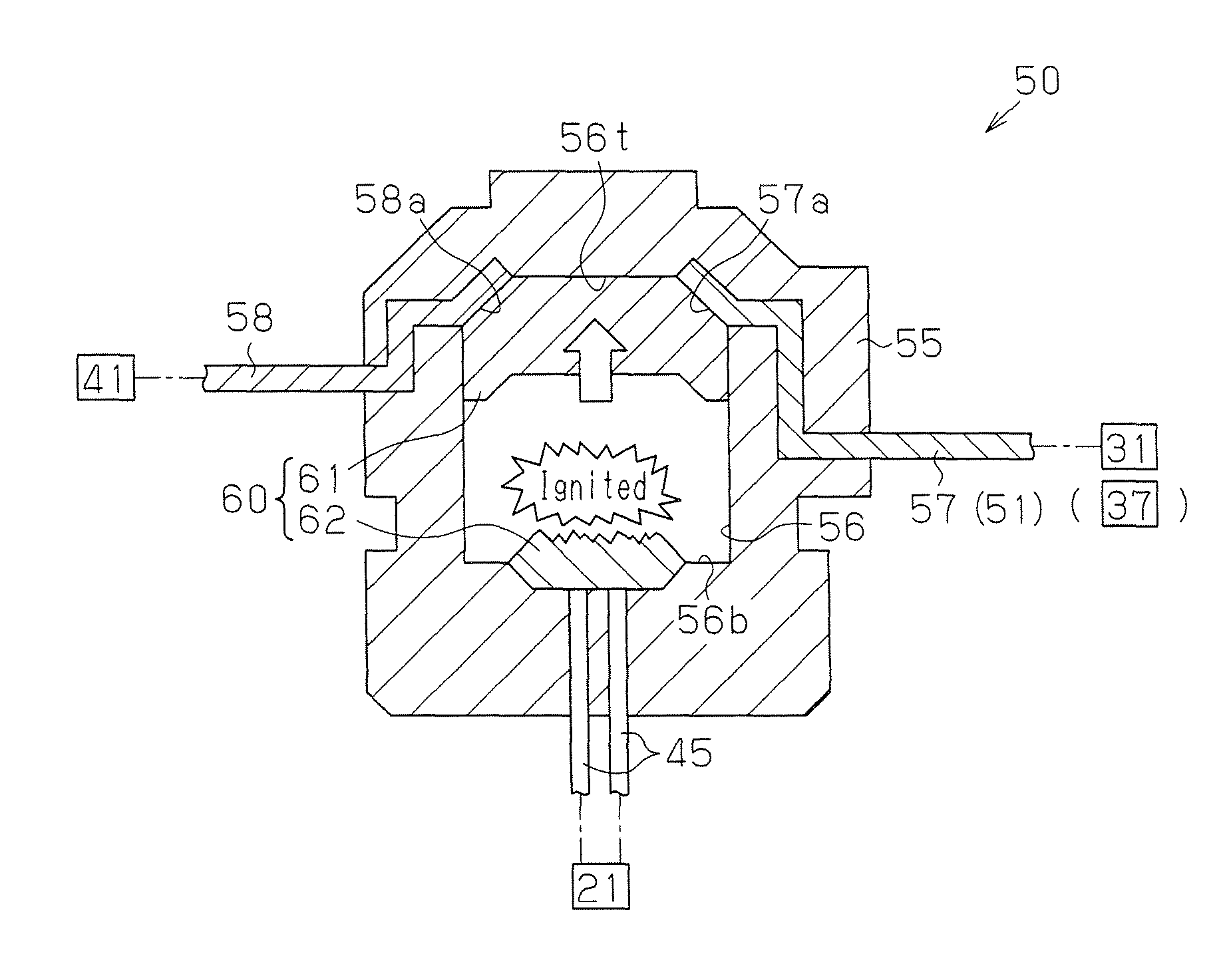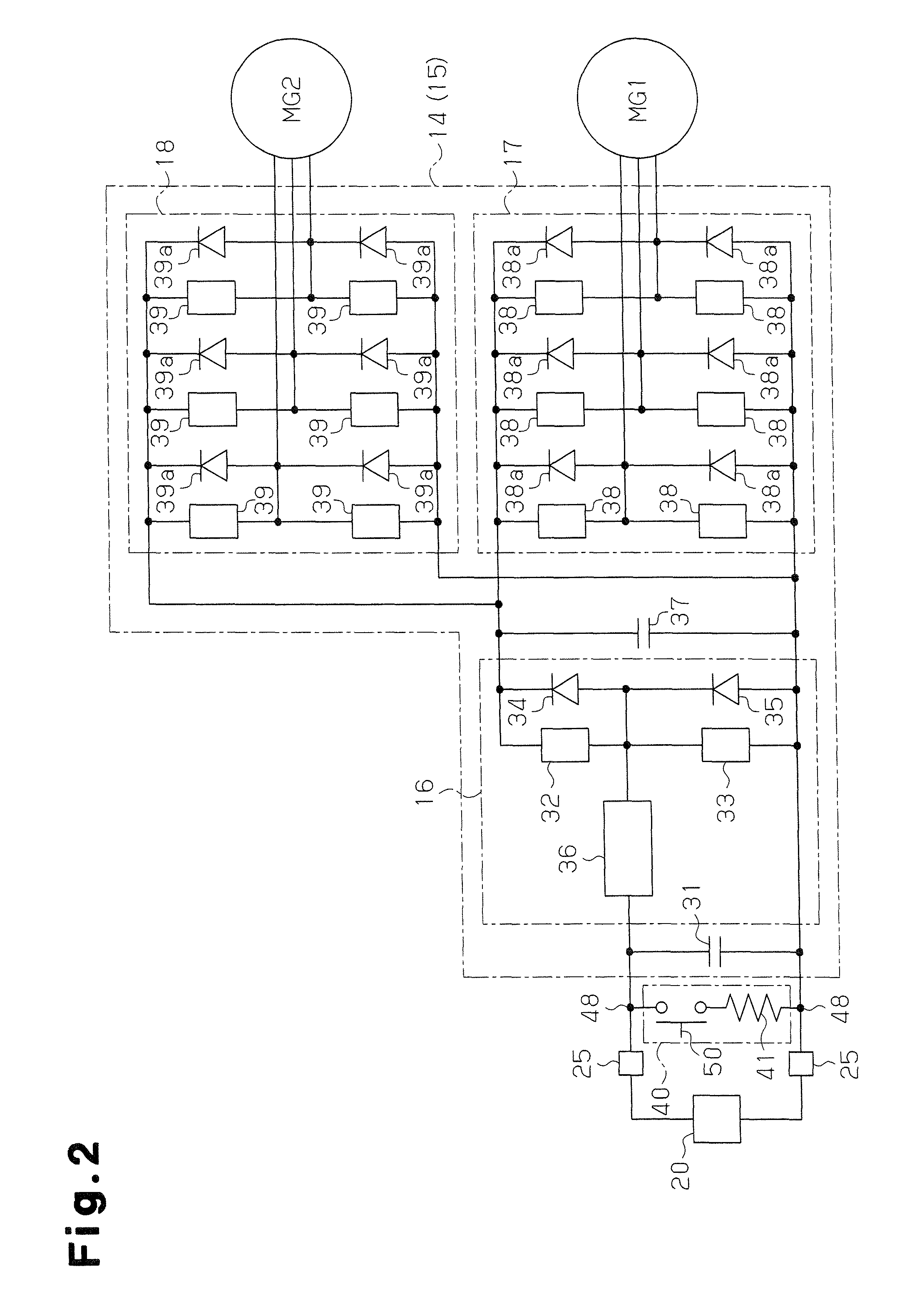Discharge device for vehicle
a technology for discharging devices and vehicles, applied in the direction of electric devices, propulsion by batteries/cells, transportation and packaging, etc., can solve the problems of electricity supply from the electricity source to the electric circuit,
- Summary
- Abstract
- Description
- Claims
- Application Information
AI Technical Summary
Benefits of technology
Problems solved by technology
Method used
Image
Examples
first embodiment
[0025]A discharge control device for a vehicle according to a first embodiment of the present invention will now be described with reference to FIGS. 1 to 5.
[0026]FIG. 1 schematically shows a hybrid vehicle (hereinafter, simply referred to a vehicle), to which the discharge device for a vehicle according to the present embodiment is applied. As shown in FIG. 1, a vehicle 10 includes, as a power source, an internal combustion engine 11, a first motor-generator MG1, a power split device 12, and a second motor-generator MG2. Three-phase alternating current synchronous motors may be used as the first and second motor-generators MG1, MG2. The power split device 12 includes a planetary gear train and distributes the power generated by the internal combustion engine 11 to the first motor-generator MG1 and drive wheels 13. The second motor-generator MG2 chiefly functions as an electric motor and generates auxiliary power for driving the drive wheels 13 separately from the power of the inter...
second embodiment
[0072]A discharge device for a vehicle according to a second embodiment of the present invention will now be described with reference to FIGS. 6 and 7.
[0073]In the second embodiment, the second capacitor 37 is discharged by the discharge mechanism 40 in addition to stopping of electricity supply from the storage battery 20 to the PCU 14 by activating the breakers 25 when a collision of the vehicle 10 is detected.
[0074]The discharge mechanism 40 has an elongated discharge mechanism case 42, a switch 50, and a discharging resistor 41. The switch 50 and the discharging resistor 41 are arranged in the discharge mechanism case 42 and connected to each other in series. A first bus bar 51 is connected to the switch 50, and a second bus bar 52 is connected to the discharging resistor 41. A part of the first bus bar 51 and a part of the second bus bar 52 include connecting terminals 51a, 52a, respectively. The terminals 51a, 52a extend through side plates 43 of the discharge mechanism case 4...
third embodiment
[0080]A discharge device for a vehicle according to a third embodiment of the present invention will now be described with reference to FIGS. 8 to 10.
[0081]In the third embodiment, the first capacitor 31 and the second capacitor 37 are discharged by a common discharge mechanism 40 in addition to stopping of electricity supply from the storage battery 20 to the PCU 14 by activating the breakers 25 when a collision of the vehicle 10 is detected.
[0082]As shown in FIG. 8, the discharge mechanism 40 has an elongated discharge mechanism case 42, a switch 50, and a discharging resistor 41. The switch 50 and the discharging resistor 41 are arranged in the discharge mechanism case 42 and connected to each other in series. Two first bus bars 51, 71 are connected to the switch 50, and a second bus bar 52 is connected to the discharging resistor 41. A part of one of the first bus bars 51 and a part of the second bus bar 52 include connecting terminals 51a, 52a, respectively. The terminals 51a, ...
PUM
 Login to View More
Login to View More Abstract
Description
Claims
Application Information
 Login to View More
Login to View More - R&D
- Intellectual Property
- Life Sciences
- Materials
- Tech Scout
- Unparalleled Data Quality
- Higher Quality Content
- 60% Fewer Hallucinations
Browse by: Latest US Patents, China's latest patents, Technical Efficacy Thesaurus, Application Domain, Technology Topic, Popular Technical Reports.
© 2025 PatSnap. All rights reserved.Legal|Privacy policy|Modern Slavery Act Transparency Statement|Sitemap|About US| Contact US: help@patsnap.com



